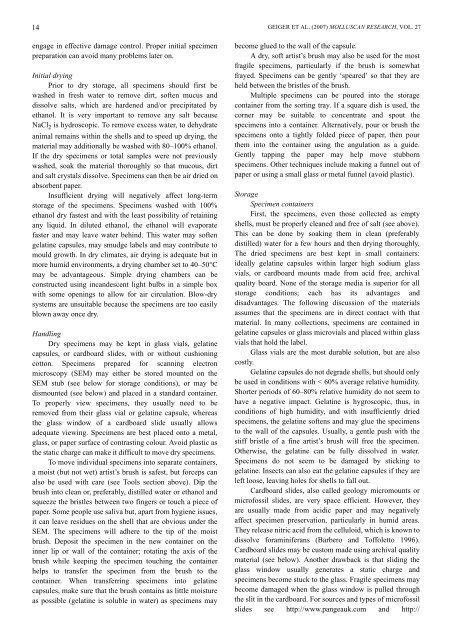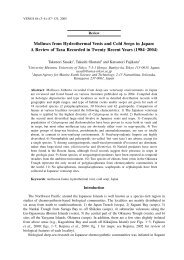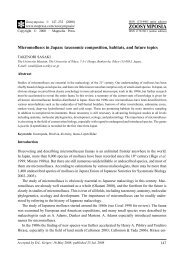Molluscan Research: Techniques for collecting, handling, preparing ...
Molluscan Research: Techniques for collecting, handling, preparing ...
Molluscan Research: Techniques for collecting, handling, preparing ...
Create successful ePaper yourself
Turn your PDF publications into a flip-book with our unique Google optimized e-Paper software.
14<br />
engage in effective damage control. Proper initial specimen<br />
preparation can avoid many problems later on.<br />
Initial drying<br />
Prior to dry storage, all specimens should first be<br />
washed in fresh water to remove dirt, soften mucus and<br />
dissolve salts, which are hardened and/or precipitated by<br />
ethanol. It is very important to remove any salt because<br />
NaCl 2 is hydroscopic. To remove excess water, to dehydrate<br />
animal remains within the shells and to speed up drying, the<br />
material may additionally be washed with 80–100% ethanol.<br />
If the dry specimens or total samples were not previously<br />
washed, soak the material thoroughly so that mucous, dirt<br />
and salt crystals dissolve. Specimens can then be air dried on<br />
absorbent paper.<br />
Insufficient drying will negatively affect long-term<br />
storage of the specimens. Specimens washed with 100%<br />
ethanol dry fastest and with the least possibility of retaining<br />
any liquid. In diluted ethanol, the ethanol will evaporate<br />
faster and may leave water behind. This water may soften<br />
gelatine capsules, may smudge labels and may contribute to<br />
mould growth. In dry climates, air drying is adequate but in<br />
more humid environments, a drying chamber set to 40–50°C<br />
may be advantageous. Simple drying chambers can be<br />
constructed using incandescent light bulbs in a simple box<br />
with some openings to allow <strong>for</strong> air circulation. Blow-dry<br />
systems are unsuitable because the specimens are too easily<br />
blown away once dry.<br />
Handling<br />
Dry specimens may be kept in glass vials, gelatine<br />
capsules, or cardboard slides, with or without cushioning<br />
cotton. Specimens prepared <strong>for</strong> scanning electron<br />
microscopy (SEM) may either be stored mounted on the<br />
SEM stub (see below <strong>for</strong> storage conditions), or may be<br />
dismounted (see below) and placed in a standard container.<br />
To properly view specimens, they usually need to be<br />
removed from their glass vial or gelatine capsule, whereas<br />
the glass window of a cardboard slide usually allows<br />
adequate viewing. Specimens are best placed onto a metal,<br />
glass, or paper surface of contrasting colour. Avoid plastic as<br />
the static charge can make it difficult to move dry specimens.<br />
To move individual specimens into separate containers,<br />
a moist (but not wet) artist’s brush is safest, but <strong>for</strong>ceps can<br />
also be used with care (see Tools section above). Dip the<br />
brush into clean or, preferably, distilled water or ethanol and<br />
squeeze the bristles between two fingers or touch a piece of<br />
paper. Some people use saliva but, apart from hygiene issues,<br />
it can leave residues on the shell that are obvious under the<br />
SEM. The specimens will adhere to the tip of the moist<br />
brush. Deposit the specimen in the new container on the<br />
inner lip or wall of the container; rotating the axis of the<br />
brush while keeping the specimen touching the container<br />
helps to transfer the specimen from the brush to the<br />
container. When transferring specimens into gelatine<br />
capsules, make sure that the brush contains as little moisture<br />
as possible (gelatine is soluble in water) as specimens may<br />
GEIGER ET AL. (2007) MOLLUSCAN RESEARCH, VOL. 27<br />
become glued to the wall of the capsule.<br />
A dry, soft artist’s brush may also be used <strong>for</strong> the most<br />
fragile specimens, particularly if the brush is somewhat<br />
frayed. Specimens can be gently ‘speared’ so that they are<br />
held between the bristles of the brush.<br />
Multiple specimens can be poured into the storage<br />
container from the sorting tray. If a square dish is used, the<br />
corner may be suitable to concentrate and spout the<br />
specimens into a container. Alternatively, pour or brush the<br />
specimens onto a tightly folded piece of paper, then pour<br />
them into the container using the angulation as a guide.<br />
Gently tapping the paper may help move stubborn<br />
specimens. Other techniques include making a funnel out of<br />
paper or using a small glass or metal funnel (avoid plastic).<br />
Storage<br />
Specimen containers<br />
First, the specimens, even those collected as empty<br />
shells, must be properly cleaned and free of salt (see above).<br />
This can be done by soaking them in clean (preferably<br />
distilled) water <strong>for</strong> a few hours and then drying thoroughly.<br />
The dried specimens are best kept in small containers:<br />
ideally gelatine capsules within larger high sodium glass<br />
vials, or cardboard mounts made from acid free, archival<br />
quality board. None of the storage media is superior <strong>for</strong> all<br />
storage conditions; each has its advantages and<br />
disadvantages. The following discussion of the materials<br />
assumes that the specimens are in direct contact with that<br />
material. In many collections, specimens are contained in<br />
gelatine capsules or glass microvials and placed within glass<br />
vials that hold the label.<br />
Glass vials are the most durable solution, but are also<br />
costly.<br />
Gelatine capsules do not degrade shells, but should only<br />
be used in conditions with < 60% average relative humidity.<br />
Shorter periods of 60–80% relative humidity do not seem to<br />
have a negative impact. Gelatine is hygroscopic, thus, in<br />
conditions of high humidity, and with insufficiently dried<br />
specimens, the gelatine softens and may glue the specimens<br />
to the wall of the capsules. Usually, a gentle push with the<br />
stiff bristle of a fine artist’s brush will free the specimen.<br />
Otherwise, the gelatine can be fully dissolved in water.<br />
Specimens do not seem to be damaged by sticking to<br />
gelatine. Insects can also eat the gelatine capsules if they are<br />
left loose, leaving holes <strong>for</strong> shells to fall out.<br />
Cardboard slides, also called geology micromounts or<br />
microfossil slides, are very space efficient. However, they<br />
are usually made from acidic paper and may negatively<br />
affect specimen preservation, particularly in humid areas.<br />
They release nitric acid from the celluloid, which is known to<br />
dissolve <strong>for</strong>aminiferans (Barbero and Toffoletto 1996).<br />
Cardboard slides may be custom made using archival quality<br />
material (see below). Another drawback is that sliding the<br />
glass window usually generates a static charge and<br />
specimens become stuck to the glass. Fragile specimens may<br />
become damaged when the glass window is pulled through<br />
the slit in the cardboard. For sources and types of microfossil<br />
slides see http://www.pangeauk.com and http://




